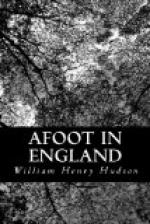The living stains, which Nature’s
hand alone,
Profuse of life, pours out upon
the stone.
Greys, greens, yellows, and browns and rust-reds are but the colours of a variety of lowly vegetable forms, mostly lichens and the aerial alga called iolithus.
Without this colouring, its “living stains,” Salisbury would not have fascinated me as it did during this last visit. It would have left me cold though all the architects and artists had assured me that it was the most perfectly beautiful building on earth.
I also found an increasing charm in the interior, and made the discovery that I could go oftener and spend more hours in this cathedral without a sense of fatigue or depression than in any other one known to me, because it has less of that peculiar character which we look for and almost invariably find in our cathedrals. It has not the rich sombre majesty, the dim religious light and heavy vault-like atmosphere of the other great fanes. So airy and light is it that it is almost like being out of doors. You do not experience that instantaneous change, as of a curtain being drawn excluding the light and air of day and of being shut in, which you have on entering other religious houses. This is due, first, to the vast size of the interior, the immense length of the nave, and the unobstructed view one has inside owing to the removal by the “vandal” Wyatt of the old ponderous stone screen—an act for which I bless while all others curse his memory; secondly, to the comparatively small amount of stained glass there is to intercept the light. So graceful and beautiful is the interior that it can bear the light, and light suits it best, just as a twilight best suits Exeter and Winchester and other cathedrals with heavy sculptured roofs. One marvels at a building so vast in size which yet produces the effect of a palace in fairyland, or of a cathedral not built with hands but brought into existence by a miracle.
I began to think it not safe to stay in that place too long lest it should compel me to stay there always or cause me to feel dissatisfied and homesick when away.
But the interior of itself would never have won me, as I had not expected to be won by any building made by man; and from the inside I would pass out only to find a fresh charm in that part where Nature had come more to man’s aid.




